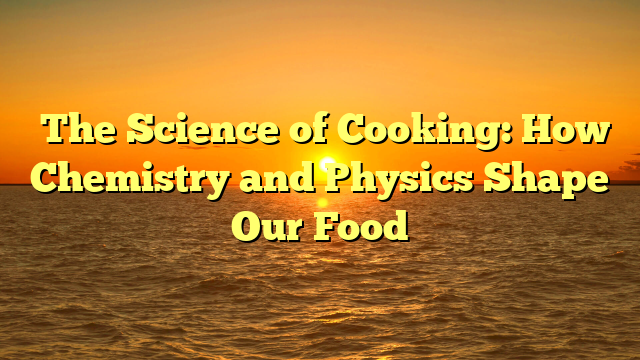Cooking is often considered an art, but at its core, it is also a science. Every time we prepare a meal, we are conducting a series of chemical and physical reactions that transform raw ingredients into delicious dishes. From the caramelization of onions to the fermentation of bread, science plays a crucial role in the flavors, textures, and aromas we experience in food.
In this article, we will explore the fascinating science behind cooking, including the role of heat, chemical reactions, and the impact of different cooking techniques on food.
The Role of Heat in Cooking
Heat is one of the most important factors in cooking, as it triggers various chemical reactions that change the composition of food. There are three primary ways heat is transferred during cooking:
1. Conduction
Conduction is the direct transfer of heat from one object to another. When you place a steak on a hot pan, heat moves from the pan to the surface of the steak, causing it to cook.
2. Convection
Convection occurs when heat is transferred through a fluid or air. In an oven, hot air circulates around the food, cooking it evenly. This is why convection ovens are popular for baking and roasting.
3. Radiation
Radiation transfers heat through electromagnetic waves. When using a broiler or grilling food over an open flame, infrared radiation cooks the surface of the food quickly.
Different cooking methods use these heat transfers in various ways, affecting how food tastes and feels in the mouth.
Key Chemical Reactions in Cooking
1. Maillard Reaction: The Secret to Golden-Brown Food
The Maillard reaction is responsible for the delicious browning of food when cooked at high temperatures. This reaction occurs when amino acids (proteins) and sugars react under heat, creating complex flavors and aromas.
Examples of the Maillard reaction include:
● The crust on a grilled steak
● The golden-brown color of toasted bread
● The crispy skin of roasted chicken
To achieve the best Maillard reaction, food should be cooked at high heat with minimal moisture. This is why chefs often pat meat dry before searing it.
2. Caramelization: Sweetening Through Heat
Caramelization happens when sugars break down and transform under heat, producing a rich, sweet, and nutty flavor. This process occurs at temperatures around 160–180°C (320–356°F).
Examples of caramelization include:
● The deep brown color of caramelized onions
● The crisp, sugary crust on crème brûlée
● The natural sweetness of roasted vegetables
3. Denaturation and Coagulation: How Proteins Change
Proteins change their structure when exposed to heat, acids, or salt. This process is called denaturation, and it is followed by coagulation, where the proteins solidify.
Examples include:
● Egg whites turning from clear to white when cooked
● Meat becoming firm as it cooks
● Milk curdling when mixed with lemon juice
4. Fermentation: The Power of Microbes
Fermentation is a process where bacteria or yeast break down sugars, producing acids, alcohol, or gas. This reaction is used to make many staple foods, including:
● Bread (yeast ferments the dough, making it rise)
● Cheese and yogurt (bacteria convert milk sugars into lactic acid)
● Kimchi and sauerkraut (fermented cabbage creates probiotics)
Fermentation not only enhances flavor but also improves digestion and preserves food.
How Cooking Methods Affect Food
Different cooking methods produce different textures, flavors, and nutritional values. Let’s explore how popular techniques affect food.
1. Boiling and Steaming
● Boiling involves cooking food in water at 100°C (212°F). It is commonly used for pasta, rice, and vegetables. However, boiling can cause some nutrients, like vitamin C, to leach into the water.
● Steaming uses hot vapor to cook food while preserving more nutrients than boiling. It is ideal for vegetables, fish, and dumplings.
2. Frying and Sautéing
● Deep frying submerges food in hot oil, creating a crispy outer layer due to the Maillard reaction. However, fried foods can absorb excess fat.
● Sautéing uses a small amount of oil and high heat to quickly cook food while keeping it tender and flavorful.
3. Grilling and Roasting
● Grilling exposes food to direct heat, creating smoky flavors and charred textures. This method is popular for meats and vegetables.
● Roasting uses dry heat in an oven to cook food evenly. Roasting brings out the natural sweetness in vegetables and creates crispy textures on meats.
4. Baking
Baking uses dry heat to cook food, often relying on the expansion of air or gas to create rise and texture. This method is used for bread, cakes, and pastries.
The Science of Taste and Flavor
Taste and flavor are influenced by the chemical compounds in food. The five basic tastes are:
1. Sweet – Comes from sugars and some amino acids (e.g., honey, fruits).
2. Salty – Comes from sodium in foods (e.g., salt, seaweed).
3. Sour – Comes from acids (e.g., citrus fruits, vinegar).
4. Bitter – Comes from alkaloids and plant compounds (e.g., coffee, dark chocolate).
5. Umami – Comes from glutamates and amino acids (e.g., mushrooms, soy sauce, cheese).
Beyond taste, aroma plays a major role in flavor perception. Many food aromas come from volatile compounds released during cooking, such as caramelized sugars or roasted coffee beans.
How Science Helps Improve Cooking
Understanding the science of cooking can help improve home cooking and professional culinary skills. Here are some practical applications:
● Using the right temperature: Knowing the ideal cooking temperature for meats and baked goods prevents undercooking or overcooking.
● Enhancing flavors with chemical reactions: Browning food properly or using fermentation can improve depth of flavor.
● Preserving nutrients: Cooking methods like steaming or stir-frying retain more vitamins compared to boiling.
● Balancing flavors: Understanding taste chemistry helps chefs create well-balanced dishes.
Conclusion
Cooking is not just about following recipes—it’s a scientific process that transforms ingredients into flavorful and nutritious meals. From jovialmedia.5g.in to chemical reactions, the science behind cooking explains why certain techniques work better than others and how flavors develop.
By applying scientific knowledge to cooking, we can enhance our skills, make better food choices, and create dishes that are both delicious and healthy. Whether you’re a home cook or a professional chef, understanding the science of cooking will help you master the kitchen with confidence!
The Science of Cooking: How Chemistry and Physics Shape Our Food










